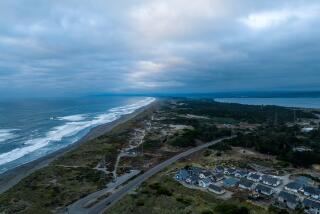Heart of a Mystery : Study Explores Why Neighboring Cities Have Widely Different Cardiovascular Death Rates
- Share via
RANCHO CUCAMONGA — For all the differences between the cities of Fontana and Rancho Cucamonga--one is an old blue-collar steel town, the other a more up-scale white-collar community--researchers are wondering which ones may prove the difference between life and death.
A benchmark study released today shows that residents of San Bernardino County are more likely than residents of any other county in California to die of cardiovascular diseases.
But in a finding that puzzles researchers, residents of Fontana are more than twice as likely to die of heart-related disease than the residents of Rancho Cucamonga, just next door.
And now the researchers are surveying residents of both cities to try to figure out why.
“We really have no idea why there’s the difference between the two--and we’re hoping the people who live there can tell us,” said Jeannie Gazzaniga, co-author of the study, which was conducted by UC San Francisco and the state Department of Health Services.
The report found that for the years 1989 to 1991, about 159 people per 100,000 died of heart disease statewide. In Fontana, the heart disease mortality rate was about 245 per 100,000 residents--far above the state average--while in Rancho Cucamonga the death rate attributable to heart disease was only about 106 per 100,000.
Gazzaniga’s researchers will conduct 25-minute telephone surveys of 2,000 residents of each city to try to determine what makes the two cities distinct. Residents will be queried on such issues as lifestyle habits--including their diet, whether they smoke and how much they exercise. They will also be asked about such socioeconomic factors as income and education levels, and their access to health care and preventive health services. Other researchers will analyze each city’s air and water quality.
The study is expected to last a year and is being funded by the federal Centers for Disease Control and Prevention.
“The results will only be applicable to those two cities, but it may explain what’s going on in other high-rate cities,” Gazzaniga said. “The very essence of this project is to identify specifically what factors lead to high heart disease rates in specific communities.”
The findings may prompt people to exercise more, she said.
Fontana Mayor David Eshleman said he encouraged the follow-up study. “I’m concerned for my constituents who are dying more frequently than they should,” he said. “I’d like to work closely with the researchers so we can find out the reason, so we can look at what we can do to reduce the risk of heart disease.”
The two cities were selected for more study because they have about the same population and had markedly different results--and not because they are next to one another, Gazzaniga said. “But that makes the results all the more curious,” she said.
The results did not surprise some residents of both cities--but their explanations varied.
“It probably boils down to socioeconomic issues--whether people in Fontana have time for recreation and exercise, or have a proper diet,” said Pat Adongo, an attorney. “Either way, I’m more glad than ever I live in Rancho Cucamonga.”
Michelle Levesque, a single mother in Fontana, agreed with Adongo. “I see what kids--and their parents--eat in this town. Hot dogs. People here don’t eat enough vegetables.”
Rancho Cucamonga residents are less stressed, said Saniyyah Rasheed, a premed student who has lived here 13 years. “Stress has a lot to do with heart disease, so I’m not surprised by the findings. Rancho Cucamonga is a higher-income area than Fontana, so they have less daily stress and can afford to eat better.”
Rancho Cucamonga’s median family income was $50,349, compared to Fontana’s median family income of $38,055, according to 1989 government statistics.
Rancho Cucamonga Mayor Bill Alexander credited the healthier hearts to his city’s emphasis on parks and outdoor recreation, and planning standards that lead to an aesthetically pleasing--and calming--environment.
He said his city is the seventh safest in the United States for those with more than 100,000 people, based on FBI statistics. That probably accounts for something, he said.
Doug Brown, an aircraft engineer who has lived in Rancho Cucamonga 15 years, hailed the news--because he’s retiring and moving next month to South Dakota, and has to sell his home.
“Hey, this will be a great marketing angle,” he said. Three bedrooms, two baths, nice yard, low heart disease.
(BEGIN TEXT OF INFOBOX / INFOGRAPHIC)
Heart Disease Hot Spots (Southland Edition, A15)
A new report for the first time gives a city-by-city breakdown of deaths from heart disease in California. The map shows the cities in Los Angeles, Ventura, Orange and San Bernadino counties with the highest relative rates of death from heart disease, compared to the state as a whole.
Deaths per 100,000
*--*
Men Women Total LOS ANGELES COUNTY Bellflower 1.08 1.47 1.26 El Monte 1.10 1.36 1.23 Inglewood 0.98 1.36 1.15 Long Beach 1.12 1.17 1.14 Los Angeles 0.99 1.10 1.04 Maywood 1.94 1.63 1.67 Norwalk 1.20 1.48 1.34 Palmdale 0.96 1.42 1.18 Paramount 1.71 1.40 1.48 Pomona 1.49 1.46 1.46 San Dimas 1.29 1.56 1.41 Whittier 1.72 1.73 1.72 ORANGE COUNTY Anaheim 1.38 1.37 1.36 Fullerton 1.18 1.24 1.21 Garden Grove 1.18 1.25 1.22 Santa Ana 1.10 1.32 1.19 RIVERSIDE COUNTY Banning 1.30 1.69 1.49 Corona 1.60 1.26 1.43 Perris 1.31 1.62 1.48 Riverside 1.62 1.61 1.61 SAN BERNARDINO COUNTY Barstow 1.72 1.41 1.55 Colton 1.54 1.59 1.59 Fontana 1.30 1.79 1.54 Hesperia 1.59 1.56 1.56 Montclair 1.69 1.58 1.60 Ontario 1.45 1.31 1.36 Redlands 1.41 1.56 1.47 Rialto 1.62 1.54 1.56 San Bernardino 1.27 1.35 1.30 Victorville 1.39 1.32 1.37 Yucaipa 1.70 0.95 1.33
*--*
Source: Cardiovascular Disease Outreach, Resources and Epidemiology Program
More to Read
Sign up for Essential California
The most important California stories and recommendations in your inbox every morning.
You may occasionally receive promotional content from the Los Angeles Times.













